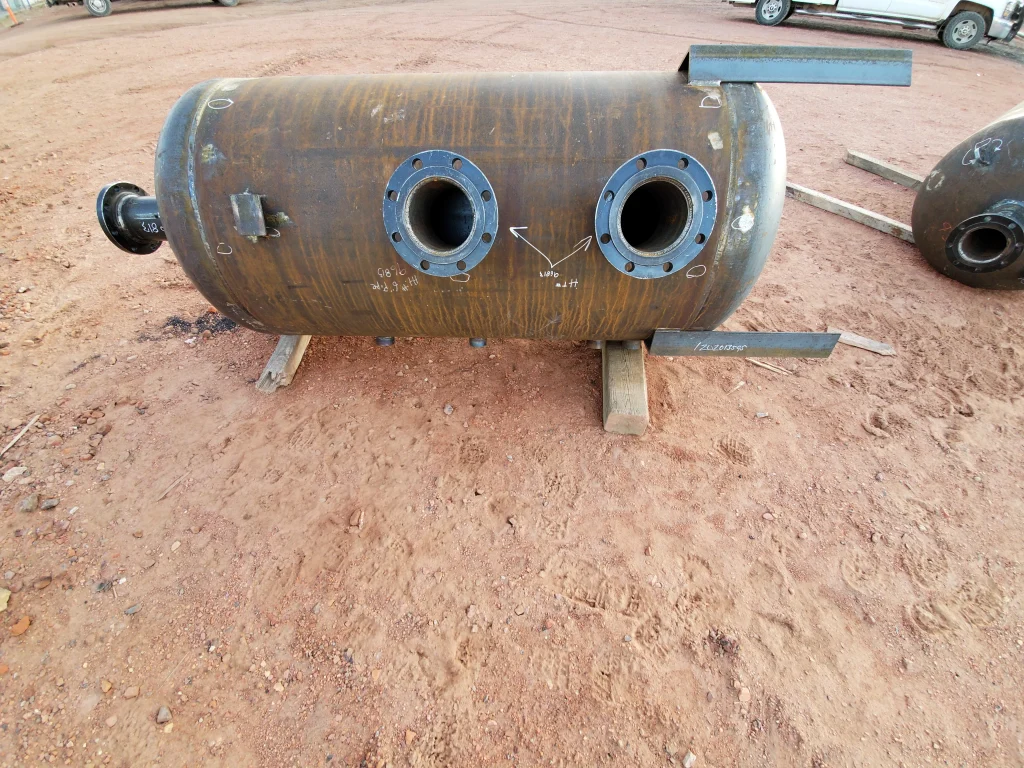
Introduction of pressure vessels are designed and built
Pressure vessels are specialized containers designed to hold gases or liquids at a pressure substantially different from the ambient pressure. These vessels play a pivotal role in numerous industries, from petrochemicals and pharmaceuticals to power generation and food processing. Their applications range from simple compressed air storage tanks in workshops to intricate reactors in chemical plants.
The importance of pressure vessels in these industries cannot be overstated. They are essential for processes that require controlled pressure and temperature conditions, and their failure can lead to catastrophic consequences, both in terms of human safety and economic losses. This underscores the significance of their design and construction.
The design and construction of pressure vessels are not merely about creating a container that can withstand internal or external pressures. It’s a meticulous process that takes into account various factors such as the type of material, the shape of the vessel, potential stress points, and the intended application. Ensuring the safety and efficiency of these vessels is paramount, and this is achieved through rigorous design standards, precise construction techniques, and regular inspections and maintenance.
Historical Context
Pressure vessels, in their most rudimentary form, have been in existence for centuries. Their origins can be traced back to simple pots and containers used to boil liquids, especially water. However, as human civilization progressed and the need for more sophisticated containment solutions arose, the design and construction of these vessels evolved significantly.
- Ancient Civilizations: The earliest pressure vessels were clay pots and sealed containers used by ancient civilizations. These were primarily for cooking and storing liquids. The principle was simple: a sealed container would increase the pressure inside as it was heated, allowing for faster cooking or distillation.
- Industrial Revolution: The 18th and 19th centuries marked a significant turning point for pressure vessels. The Industrial Revolution brought about the need for large-scale boilers and steam engines. These boilers, made of riveted steel plates, were the precursors to modern pressure vessels. They played a pivotal role in powering locomotives, factories, and ships.
- 20th Century Advancements: With the advent of petrochemical industries and nuclear power plants in the 20th century, the demand for high-quality, durable, and safe pressure vessels skyrocketed. This period saw the introduction of advanced materials, welding techniques, and computational methods for design and analysis. The ASME Boiler and Pressure Vessel Code, established in the early 20th century, became the gold standard for pressure vessel design and construction, ensuring safety and reliability.
- Modern Era: Today, pressure vessels are integral components in numerous industries, from aerospace to pharmaceuticals. Advancements in materials science, such as the introduction of composite materials, have allowed for lighter, stronger, and more corrosion-resistant vessels. Additionally, computer-aided design (CAD) and finite element analysis (FEA) have revolutionized the way these vessels are designed, allowing for more complex and efficient shapes.
Key Milestones:
- Ancient Times: People used simple pots and containers for cooking and storage.
- Industrial Revolution: Engineers introduced riveted steel boilers for steam engines.
- Early 20th Century: The ASME established the Boiler and Pressure Vessel Code.
- Late 20th Century: Designers adopted advanced materials and computational methods for pressure vessels.
- 21st Century: Engineers integrated smart sensors and IoT to enable real-time monitoring and predictive maintenance.
Basic Principles of Pressure Vessel Design
Pressure vessels are engineered structures that store gases or liquids under pressures significantly different from the surrounding environment. Designers prioritize safety and efficiency, using several core principles to guide the vessel’s construction:
Understanding the Forces Acting on a Pressure Vessel
Internal Pressures:
- The fluid inside the vessel—either gas or liquid—exerts pressure on its walls. This pressure depends on the fluid’s volume and temperature. If engineers ignore these forces, the vessel may fail catastrophically.
External Pressures:
- Although less common, external pressures occur when vessels operate in vacuum conditions or underwater. In such cases, the environment pushes inward on the vessel. Without proper design, this can lead to implosion.
Importance of Material Selection
- Strength and Durability:
- The material chosen for a pressure vessel must be strong enough to withstand the internal and external pressures it will face. Materials like carbon steel, stainless steel, and various alloys are commonly used due to their strength and durability.
- Corrosion Resistance:
- Over time, the interaction between the contained substance and the vessel material can lead to corrosion. Selecting corrosion-resistant materials or applying protective coatings can significantly extend the vessel’s lifespan.
- Temperature Tolerance:
- Pressure vessels often operate under varying temperature conditions. The chosen material should have a high tolerance to temperature fluctuations to prevent structural weaknesses.
- Cost-effectiveness:
- While it’s essential to choose high-quality materials, cost considerations also play a role. The challenge is to find a balance between quality and cost.
The Role of Geometry and Shape in Pressure Vessel Design
- Stress Distribution:
- The shape of a pressure vessel affects how stress is distributed across its surface. Cylindrical and spherical shapes are preferred because they distribute stress evenly and are inherently stronger against internal pressures.
- Space Considerations:
- The vessel’s shape can be influenced by the available space at the installation site. For instance, horizontal cylindrical vessels might be chosen for ground installations, while vertical ones are preferred when height is not a constraint.
- Efficiency:
- The shape can also influence the efficiency of processes occurring inside the vessel, especially in cases where mixing or specific flow patterns are desired.
Design Considerations
Material Selection
Choosing the right material plays a key role in designing pressure vessels. The correct material boosts longevity, safety, and efficiency. These are the major factors engineers consider:
- Corrosion Resistance: Engineers select materials that can resist corrosion, especially in vessels that contain or face corrosive substances. If not properly chosen, corrosion can weaken the vessel over time and cause failure.
- Temperature Tolerance: Designers consider the vessel’s environment. If it operates under extreme temperatures, the material must maintain its integrity.
- Cost: While safety and functionality remain essential, engineers must also consider budget constraints. They aim to balance performance with affordability.
- Commonly Used Materials: Engineers often use stainless steel due to its corrosion resistance and strength. Depending on the application, they may also choose carbon steel, aluminum, nickel alloys, or titanium.
Wall Thickness Determination
Wall thickness is critical to both the vessel’s safety and performance. Engineers determine the ideal thickness using two main approaches:
- Calculations: They apply formulas from mechanical and material science to compute the required wall thickness. These formulas include variables such as maximum expected pressure, vessel diameter, and material tensile strength.
- Considerations: Engineers also factor in potential wear and tear, corrosion rate, and safety margins. In some cases, they may increase wall thickness beyond the basic calculations to ensure extra protection.
Safety Factors
Safety plays a central role in pressure vessel design. Here’s how engineers incorporate it:
- Importance: Engineers apply a safety factor to ensure the vessel withstands more than its expected maximum pressure. This extra margin protects the vessel from unexpected pressure spikes or weaknesses over time.
- Regulatory Standards: Regulatory bodies like the American Society of Mechanical Engineers (ASME) enforce minimum safety factor standards. Following these guidelines ensures compliance with industry benchmarks.
- Implications on Design Safety: By complying with standards and applying safety factors, engineers reduce the risk of failure—even under extreme conditions. This approach protects both the personnel and the environment.
Construction Techniques
Welding Methods
Welding forms the backbone of pressure vessel construction. It guarantees structural integrity and safety. Engineers choose from several methods based on the application:
- Shielded Metal Arc Welding (SMAW): Also called stick welding, SMAW is one of the oldest and most widely used techniques. It adapts well to different environments, making it suitable for various applications.
- Gas Tungsten Arc Welding (GTAW): Also known as TIG welding, GTAW delivers high precision and works best for welding thin stainless steel and non-ferrous metals. Engineers prefer it for critical joints that require clean, high-quality welds.
- Gas Metal Arc Welding (GMAW): Commonly referred to as MIG welding, GMAW automates the welding process with a continuous wire feed. It handles both thin and thick sections efficiently.
- Submerged Arc Welding (SAW): This method generates an arc between a wire and the workpiece under a protective blanket of granular flux. It enables deep penetration and produces strong welds, making it ideal for large vessels.
- Electroslag Welding (ESW): ESW excels in welding thicker materials. Engineers often use it for the longitudinal seams of large-diameter pressure vessels.
Each method serves specific applications, influenced by the material type, wall thickness, and desired weld quality.
Inspection and Quality Control
To ensure long-term performance and safety, engineers apply strict inspection and quality control procedures at every construction stage:
- Regular Inspections: From raw material delivery to final assembly, inspectors evaluate each stage to catch defects early. Common techniques include visual checks, ultrasonic testing, and radiography.
- Material Verification: Before construction begins, engineers test materials to confirm they meet specifications. These tests cover composition, tensile strength, and corrosion resistance.
- Weld Quality Control: Since welds are critical to integrity, inspectors apply methods like dye penetrant testing, magnetic particle testing, and X-ray inspection to detect any flaws.
- Dimensional Checks: Engineers confirm that the vessel’s dimensions align with design specs. Precise measurements ensure it performs correctly under pressure.
- Hydrostatic Testing: After assembly, engineers fill the vessel with water and apply pressure to test its structural integrity. This confirms that the vessel can withstand its intended operating pressure.
- Documentation and Certification: Inspectors document each test and inspection. After confirming compliance, they issue certifications proving that the vessel meets industry standards.
Testing Procedures
Engineers run comprehensive tests to confirm that pressure vessels can handle operational stresses. These procedures protect both equipment and personnel. Here’s how they do it:
Hydrostatic Testing
Purpose: Engineers fill the vessel with liquid—usually water—and pressurize it beyond normal levels to check for leaks and confirm structural strength.
Procedure:
- Engineers seal and fill the vessel with water.
- They increase the pressure to 1.5 times the vessel’s normal operating limit.
- They hold this pressure to inspect for leaks or signs of deformation.
Significance: This non-destructive test reveals weak points in welds or materials, allowing engineers to fix issues before deployment.
Radiographic Testing
Purpose: Engineers use X-rays or gamma rays to inspect a vessel’s internal structure. This technique identifies flaws like cracks or inclusions that visual inspections might miss.
Procedure:
- They place a radiographic film on one side of the vessel.
- An X-ray or gamma-ray source is positioned on the opposite side.
- The rays pass through the vessel, creating an image on the film and revealing internal flaws.
Significance: This method provides detailed insights into the vessel’s internal structure. It helps engineers detect even minor defects and ensures long-term safety and reliability.
Other Common Testing Methods
- Ultrasonic Testing: Engineers apply high-frequency sound waves to detect internal and surface defects.
- Magnetic Particle Testing: Technicians use magnetic fields to reveal surface and near-surface issues in ferromagnetic materials.
- Dye Penetrant Testing: A colored dye applied to the surface highlights cracks or defects once it seeps into them.
Ensuring Vessel Integrity Before Deployment
Before deploying a pressure vessel, engineers must confirm its complete structural integrity. They eliminate both internal and external defects through rigorous testing. These tests simulate or exceed the vessel’s expected working conditions.
By verifying performance under stress, manufacturers confirm the vessel meets safety standards and is ready for service. Only vessels that pass all required tests qualify for deployment.
Regulatory and Industry Standards
Pressure vessels operate across critical industries, from petrochemicals to power generation. Due to the risks involved, engineers must follow strict industry regulations.
These standards govern how engineers design, build, and operate vessels. By complying with these regulations, manufacturers reduce risk and protect both people and the environment.
Key Regulatory Bodies and Their Guidelines:
- ASME (American Society of Mechanical Engineers): Perhaps the most recognized authority globally, ASME has set the benchmark with its Boiler and Pressure Vessel Code (BPVC). This comprehensive set of standards outlines the requirements for the design, fabrication, inspection, and testing of boilers and pressure vessels.
- PED (Pressure Equipment Directive): For European countries, the PED provides the legislative framework for pressure equipment and assemblies. It ensures that pressure vessels meet essential safety requirements, especially concerning potential hazards.
- API (American Petroleum Institute): Particularly relevant for the oil and gas industry, API has established standards like API 510, which pertains to the inspection, repair, alteration, and rerating of in-service pressure vessels.
- ISO (International Organization for Standardization): ISO has various standards related to pressure vessels, ensuring that they are consistent with international best practices.
- Local Regulatory Bodies: Apart from the international organizations, each country may have its regulatory bodies that set specific guidelines tailored to their region’s needs and challenges.
Importance of Adhering to Industry Standards:
- Safety: The primary reason for these standards is safety. Pressure vessels operate under extreme conditions, and any failure can lead to catastrophic consequences, including explosions, fires, and toxic releases. Adhering to standards ensures that vessels are designed and constructed to withstand these conditions.
- Efficiency: Properly designed and constructed pressure vessels not only ensure safety but also optimize performance. This means that operations run smoothly, with minimal downtime and maximum output.
- Economic Implications: Non-compliance can lead to hefty fines and legal repercussions. Moreover, incidents resulting from non-compliance can result in significant financial losses due to operational downtime, damage to equipment, and potential litigation.
- Reputation: Companies that consistently adhere to industry standards are viewed as trustworthy and reliable by clients, partners, and stakeholders. This reputation can lead to more business opportunities and a competitive edge in the market.
Modern Innovations in Pressure Vessel Design and Construction
- In the ever-evolving world of engineering and technology, pressure vessel design and construction have not been left behind. The industry has witnessed a plethora of innovations that have significantly improved the safety, efficiency, and longevity of these critical components. Here’s a closer look at some of the modern advancements in this domain:
Advancements in Materials
- Composite Materials: Traditional pressure vessels predominantly used metals like steel and aluminum. However, the introduction of composite materials, especially carbon-fiber-reinforced polymers, has revolutionized the industry. These composites offer superior strength-to-weight ratios, corrosion resistance, and can be tailored for specific applications.
- High-Strength, Low-Alloy Steels: These are specially designed steels that offer higher strength without compromising ductility. They are particularly beneficial for pressure vessels that operate under extreme conditions, ensuring durability and safety.
- Corrosion-Resistant Coatings: The internal environment of a pressure vessel can be highly corrosive, depending on its application. Modern coatings, such as ceramic-based or polymer coatings, have been developed to resist such corrosive environments, thereby extending the vessel’s lifespan.
Advancements in Construction Techniques
- Automated Welding: The advent of automated welding techniques, such as robotic welding, has enhanced the precision and consistency of welds. This not only ensures a higher quality of construction but also reduces human error and increases production speed.
- 3D Printing: Additive manufacturing or 3D printing is now being explored for creating pressure vessel components. This technique allows for intricate designs that were previously challenging or impossible to achieve using traditional methods.
The Role of Technology in Enhancing Design Precision and Construction Efficiency
- Computer-Aided Design (CAD): Modern pressure vessel design heavily relies on CAD software, which allows engineers to create detailed 3D models, run simulations, and test different scenarios before the actual construction begins.
- Finite Element Analysis (FEA): This computational method is used to predict how a pressure vessel will react to external forces, such as pressure and temperature. By using FEA, designers can optimize the vessel’s structure, ensuring its safety and efficiency.
- Digital Twins: This is a digital replica of a physical pressure vessel. Using sensors and real-time data, engineers can monitor the vessel’s performance, predict maintenance needs, and ensure optimal operation throughout its lifecycle.
- Augmented Reality (AR) and Virtual Reality (VR): These technologies are being used for training purposes, allowing engineers and technicians to get a virtual hands-on experience before working on the actual vessel. It’s also being used for remote inspections and maintenance guidance.
In conclusion, the modern innovations in pressure vessel design and construction are a testament to the industry’s commitment to safety, precision, and efficiency. As technology continues to advance, we can expect even more groundbreaking solutions that will further revolutionize this critical field.
Need a reliable partner?
Red River specializes in the design and manufacturing of pressure vessels. We also fabricate related items such as prefabricated spools and skid packages.
Reach Out to us today and experience the Red River difference. Where American Made and American Values come together, we care more.
FAQ: Design and Construction of Pressure Vessels
What are the key factors considered in the design of a pressure vessel?
The key factors considered in the design of a pressure vessel include the operational pressure and temperature, the type of substance it will contain (liquid, gas, or vapor), corrosion allowances, the environment in which it will operate, and the applicable regulatory and safety standards, such as those set by the American Society of Mechanical Engineers (ASME). Material selection, thickness, and shape are also crucial considerations to ensure safety and functionality.
How is the material for a pressure vessel chosen?
Material for a pressure vessel is chosen based on its ability to withstand the internal pressure, temperature conditions, and chemical compatibility with the contents. Factors such as strength, ductility, corrosion resistance, and impact resistance at operating temperatures are critical. Common materials include carbon steel, stainless steel, and alloys tailored for specific conditions and substances.
What are the most common types of pressure vessels and their uses?
The most common types of pressure vessels are storage tanks, which are used for holding liquids or gases at a higher or lower than atmospheric pressure; reactors, which facilitate chemical reactions under pressure; heat exchangers, which transfer heat between two or more fluids; and boilers, which generate steam under pressure. Each type serves different industrial purposes, from chemical processing to power generation.
What role does welding play in the construction of pressure vessels?
Welding is a critical process in the construction of pressure vessels, providing the means to join metal parts securely to handle high pressures. The quality of welding directly impacts the vessel’s integrity and safety. Welders must follow precise procedures and standards, such as those outlined by ASME, to ensure that welds are defect-free and capable of withstanding the operational stresses.
How are pressure vessels tested for safety and integrity?
Pressure vessels are tested for safety and integrity using non-destructive testing (NDT) methods, such as ultrasonic testing, radiography, and magnetic particle inspection, to detect surface and subsurface flaws. Hydrostatic testing, where the vessel is filled with water and pressurized beyond its design pressure, is also performed to ensure it can safely hold its intended pressure without leaking.
Related Blog Post
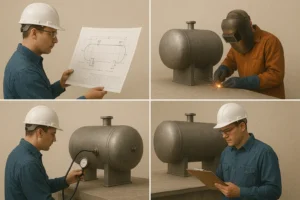
Pressure Vessel Design & Engineering: Concept to Launch
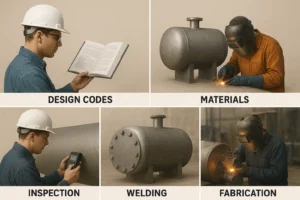
What is Pressure Vessel Design and Engineering: Code-Ready Guide
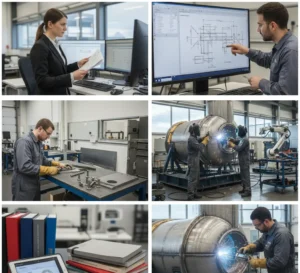
What are the Key Factors in Pressure Vessel Engineering
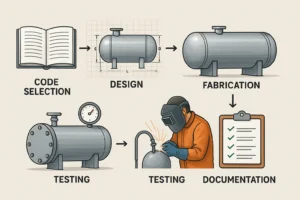
How Do You Design a Pressure Vessel: A Step-By-Step Guide
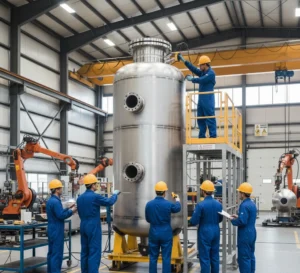
What is Pressure Vessel Fabrication and Manufacturing
About Author

